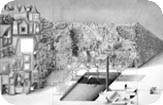|
 Lidonob, 2000, graphite on paper
Lidonob, 2000, graphite on paper
Paul Noble produces paintings, drawings, photographs, constructions,
installations, and also publishes small books. Much of his
art consists of unfinished series of primarily imaginative
content. His most ambitious project, which has been in progress
since 1995, involves the urban planning of an imaginary city
and its immediate vicinity called Nobsontown. It is an ironic
commentary - with a unique brand of humour - on late 20th
century urbanisation. Particularly eloquent is his motto:
no style, no technique, no accidents, only mistakes. Today's
urban processes in fact do not lead to well-designed and organised
built-up city clusters, they do not support urban centralisation
or concentration, but rather, tend towards ever greater dispersal.
Thus the role of the city is being transferred to a kind of
a broader urban environment; city limits are being obliterated,
and the idea of the community of a given city is vanishing.
Paul Noble published a small book titled Nobson Newtown, a
fairy tale of the origins of the founding and building of
a new town. In order to build a new town, the old one had
to be torn down. But before doing so, the town inhabitants
were asked to provide proposals for a healthy urban centre.
In the design of the new town, the temples, or spaces for
worshipping religious cults, and government buildings were
left out according to the wishes of the people, because they
simply did not need them. Just like other towns, Nobsontown
also has a park intended primarily for recreation; a cave
linked to the cults of the ancestors and their religious rituals;
a club where people gather regardless of their social status
and material wealth, and a city centre. The club and the city
centre are the two features, in particular, that resemble
no other such place in a conventional town. The club because
it has no specific regulations, and the city centre, because
it is non-existent. There is only an empty plot of land. All
of these urban elements are divided into districts. The residential
district and all the architecture in general are based on
principles of geometric bases which clearly define their basic
function.

|
|

